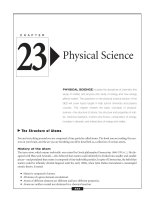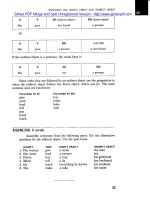3 14 how sound works (physical science)
Bạn đang xem bản rút gọn của tài liệu. Xem và tải ngay bản đầy đủ của tài liệu tại đây (2.83 MB, 10 trang )
Genre
Nonfiction
Comprehension Skill
Compare and
Contrast
Text Features
•
•
•
•
Captions
Labels
Diagrams
Glossary
Science Content
Sound
Scott Foresman Science 3.14
ISBN 0-328-13848-7
ì<(sk$m)=bdieih< +^-Ä-U-Ä-U
Vocabulary
What did you learn?
compression wave
pitch
vibration
1. How is sound produced?
2. What does plucking or rubbing the
strings of a violin do?
3. Sound travels fastest through which
type of matter? Why?
Picture Credits
Every effort has been made to secure permission and provide appropriate credit for photographic material.
The publisher deeply regrets any omission and pledges to correct errors called to its attention in subsequent editions.
Photo locators denoted as follows: Top (T), Center (C), Bottom (B), Left (L), Right (R), Background (Bkgd).
13 (Bkgd, BR) Getty Images.
Scott Foresman/Dorling Kindersley would also like to thank: 3 Kim Taylor/DK Images; 15 Denoyer-Geppert
International/DK Images; 7 (TL) Stephen Oliver/DK Images.
Unless otherwise acknowledged, all photographs are the copyright © of Dorling Kindersley, a division of Pearson.
ISBN: 0-328-13848-7
Copyright © Pearson Education, Inc. All Rights Reserved. Printed in the United States of America.
This publication is protected by Copyright, and permission should be obtained from the publisher prior to any
prohibited reproduction, storage in a retrieval system, or transmission in any form by any means, electronic,
mechanical, photocopying, recording, or likewise. For information regarding permission(s), write to
Permissions Department, Scott Foresman, 1900 East Lake Avenue, Glenview, Illinois 60025.
3 4 5 6 7 8 9 10 V010 13 12 11 10 09 08 07 06 05
4.
In this book
you have readbyabout
sound.
Write
Wendy
Weiss
to explain how your ears help you
hear sound. Include details from
the book.
5.
Compare and Contrast Sound
vibrations can be fast or slow.
How is the pitch of a slow vibration
different from the pitch of a
faster vibration?
IRP CHIRP
CH
CH
What Sound Is
Sounds are all around us. Think about
how many sounds you hear each morning.
What wakes you up in the morning? Does an
alarm clock ring? What do you eat for breakfast?
Your parents may cook eggs. The eggs probably
sizzle in the frying pan. These are sounds you
may hear in the morning.
N
RI
What sound does
an ambulance
make?
G
RIN G
RIN G
SIZZLE
SI
Z
ZL
ES
E
I ZZ L
2
IRP
Some sounds may bother you. They may be
so loud that they hurt your ears. Fire truck and
ambulance sirens may make you cover your ears.
Other sounds may bother you when you are
trying to do something else.
Luckily, many sounds are nice to hear. Do you
like to listen to music? There are many different
types of music. Most people have a favorite
type of music they like to listen to. There are
sounds in nature too. Maybe you like to listen
to chirping birds or a rushing river.
3
All the different sounds in the world are created
in the same way. Sounds are made when matter
moves back and forth really fast. A vibration is
the back-and-forth movement of matter. When
something vibrates, a sound is created.
Sounds can be loud or soft. Loudness describes
how loud or soft sound is. Big vibrations make loud
sounds. Small vibrations make soft sounds. Sounds
can also be high or low. Pitch tells you how high
or low sound is. Slow vibrations have a low pitch.
Faster vibrations have a higher pitch.
You can learn something about vibrations
when you listen to the loudness and pitch of
sounds around you.
When a book falls off a desk and hits the
floor, it makes a loud, low thud. The sound
is loud. The pitch is low. Does that mean the
vibrations are big or small? Fast or slow?
The book’s big vibrations are slow.
Now think about tapping a water glass with
a spoon. What type of sound would you hear?
Loud or soft? High or low?
Tuning fork
TIN
G
TING
Vibrating cymbal
The vibrations of the
tuning fork are causing
the water to splash.
4
5
How Sound Is Made
What sound does a
triangle make if you
hit it with a metal rod?
Let’s explore how sound is made. When a book
is dropped and a glass is tapped, two different
sounds are made in two different ways. Animals
are also able to make sounds in a number of ways.
An elephant makes a loud, trumpeting sound
when it is upset. Just like people, elephants force
air past their vocal cords in order to make a
sound. Some insects, such as the grasshopper,
make chirping sounds by rubbing their wings.
Trunk
Wing
An elephant uses its trunk
and throat to make a loud,
trumpeting sound.
6
Can you describe the sound
that two wooden sticks make
when you hit them together?
A grasshopper uses
its wings to make
a chirping sound.
Musical instruments make sounds in different
ways too. Hitting two objects together can create
musical sounds. Wooden blocks and sticks are
great for making music. Think about the pretty
ringing sound a music triangle makes when you
hit it with a metal rod.
7
A violin is a stringed musical instrument.
The strings make musical sounds when someone
pulls at, or plucks, them. Rubbing a bow across
the strings also creates sound. When you pull
at or rub the strings, they begin to move. Their
vibrations make sound. When you pluck a violin
string, you can make a short sound. If you rub a
bow across that string, you can make a sound that
lasts as long as you want.
Blow into bottles filled with liquid. Does the amount
of liquid change the sound each bottle makes?
This girl is rubbing the strings
of a violin with a bow.
8
You can also use air to make sounds. In order
to talk, you need to let out air. The air passes
over your vocal cords. They make the air vibrate.
The tighter your vocal cords are, the higher the
pitch of your voice.
Think about blowing into an empty glass
bottle. Does this make a sound? If you do it right,
yes! Can you whistle? If you can, it is because you
are able to push air out through your lips. This
causes the air to vibrate.
9
How Sound Moves
You now know that sound is created by
vibrations. You have also learned how different
sounds are made by using air, by hitting objects,
or by pulling and rubbing strings. But how does
sound get from the place where it is made to
your ears?
Sound can travel through all three forms of
matter—solids, liquids, and gases. Sound comes
from vibrations. These vibrations make particles
of matter squeeze together and move apart very,
very quickly. This type of vibration makes a wave
pattern that scientists call a compression wave.
All sound waves are compression waves.
Area of squeezed air particles
Direction of sound wave
This sound wave is traveling through the air. The area
of squeezed particles moves along the wave. It moves
in the direction the sound is traveling.
10
11
Sound travels
through steel
at 5,200 meters
per second.
Sound travels
through water
at 1,530 meters
per second.
Sound travels
through air
at 340 meters
per second.
Ball made
of steel
Bowl of water
Balloon filled
with air
We usually cannot see sound traveling through
matter. Scientists have special tools to measure the
size and speed of sound waves. Scientists know that
sound travels fastest through solids. This is because
the particles are closest together in this form of
matter. Since the particles are so close together,
they bump into each other more easily. Then the
wave is able to move quickly through the particles.
Sound moves the slowest through gases. Gas
particles are spread far apart and cannot transfer
vibrations as easily or quickly.
12
Some sound waves have special names. Echoes
are sound waves that have been traveling forward
but suddenly hit a large, solid object. Then the
waves bounce back the way they came. Echoes are
fun to hear, such as when you shout your name
while standing in an empty gym.
Echoes are also useful. Scientists use a type
of echo called sonar to figure out how deep the
ocean is. They do this by sending a sound wave
to the bottom and waiting for it to bounce back.
The depth is based on how long this takes.
Ships use sonar to
measure ocean depths.
13
How We
Hear Sounds
What happens when sounds reach your ears?
Ears are shaped to catch the sounds from all
around us. Each part of the ear has a special job.
Think about the shape of your ear. Does it
seem silly to you? It’s actually very useful. The
cuplike shape collects sounds that travel near
the ear. The shape also helps move these sounds
inside the ear.
As sound waves travel into the ear, the first
thing they reach is the eardrum. The eardrum is a
thin, skinlike layer that stretches across the inside
of the ear. When sound waves hit the eardrum,
it begins to vibrate. Then these vibrations move
farther into the ear.
R I NG
Next, the vibrations reach three tiny bones
that touch the eardrum. These bones vibrate
when the eardrum does. They pass the sound
along to the inner ear.
The inner ear has a part that is shaped like
a shell and is lined with tiny hairs. This part is
full of liquid. The vibrations from the tiny bones
make the hairs in the liquid vibrate. These hairs
are attached to nerves that carry vibration signals
to the brain. The brain then identifies the sound.
Parts of the ear
Eardrum
Ear bones
Inner ear
RING
Outer ear
14
15
What did you learn?
Vocabulary
Glossary
compression wave
pitch
compression
vibration wave a sound wave created by
the in-and-out movement
of particles of matter
pitch
vibration
the speed of vibrations that
create a low or high sound
Photo locators denoted as follows: Top (T), Center (C), Bottom (B), Left (L), Right (R), Background (Bkgd).
13 (Bkgd, BR) Getty Images.
Scott Foresman/Dorling Kindersley would also like to thank: 3 Kim Taylor/DK Images; 15 Denoyer-Geppert
International/DK Images; 7 (TL) Stephen Oliver/DK Images.
Unless otherwise acknowledged, all photographs are the copyright © of Dorling Kindersley, a division of Pearson.
ISBN: 0-328-13848-7
Copyright © Pearson Education, Inc. All Rights Reserved. Printed in the United States of America.
This publication is protected by Copyright, and permission should be obtained from the publisher prior to any
prohibited reproduction, storage in a retrieval system, or transmission in any form by any means, electronic,
mechanical, photocopying, recording, or likewise. For information regarding permission(s), write to
Permissions Department, Scott Foresman, 1900 East Lake Avenue, Glenview, Illinois 60025.
16
2. What does plucking or rubbing the
strings of a violin do?
3. Sound travels fastest through which
type of matter? Why?
4.
In this book
you have read about sound. Write
to explain how your ears help you
hear sound. Include details from
the book.
5.
Compare and Contrast Sound
vibrations can be fast or slow.
How is the pitch of a slow vibration
different from the pitch of a
faster vibration?
very quick back-and-forth
movement of matter
Picture Credits
Every effort has been made to secure permission and provide appropriate credit for photographic material.
The publisher deeply regrets any omission and pledges to correct errors called to its attention in subsequent editions.
3 4 5 6 7 8 9 10 V010 13 12 11 10 09 08 07 06 05
1. How is sound produced?









